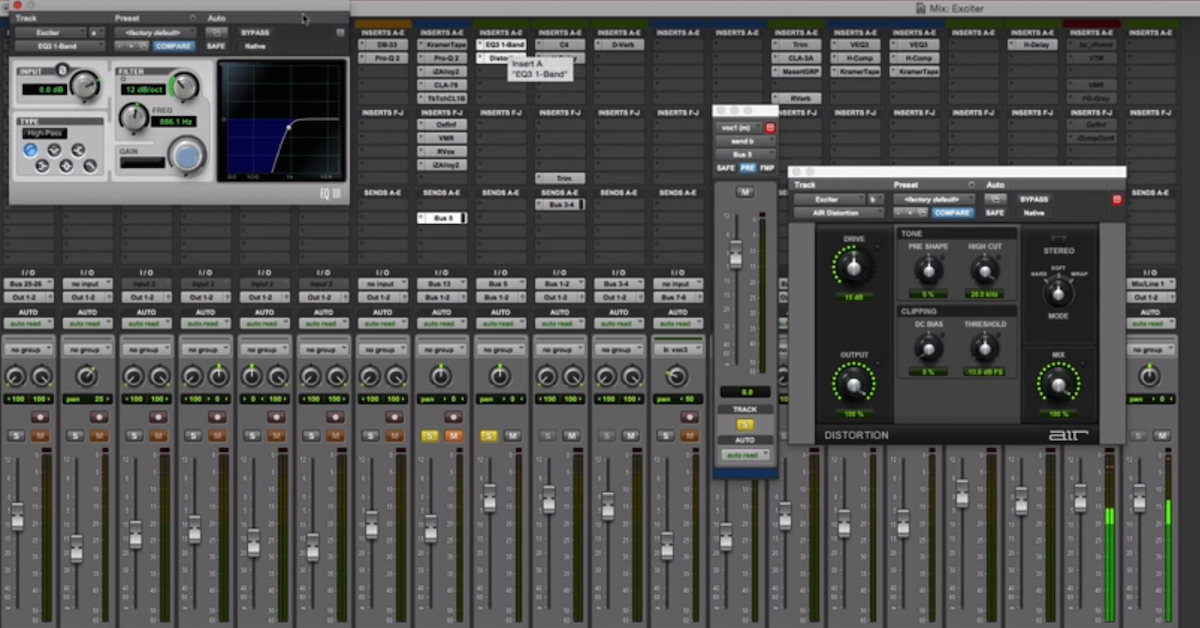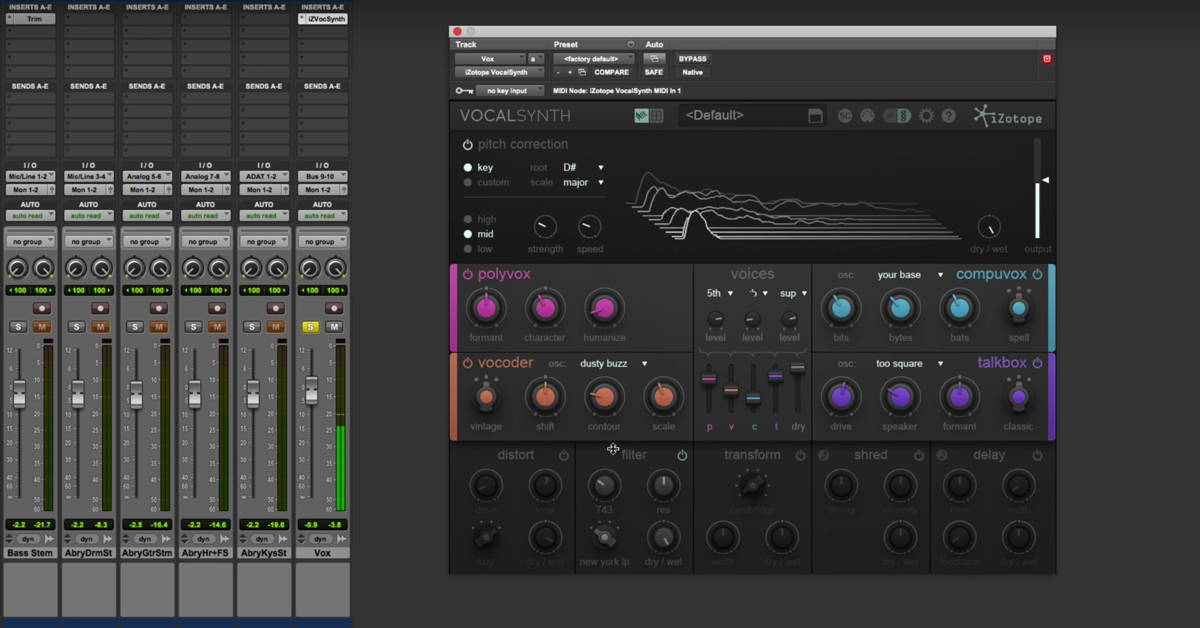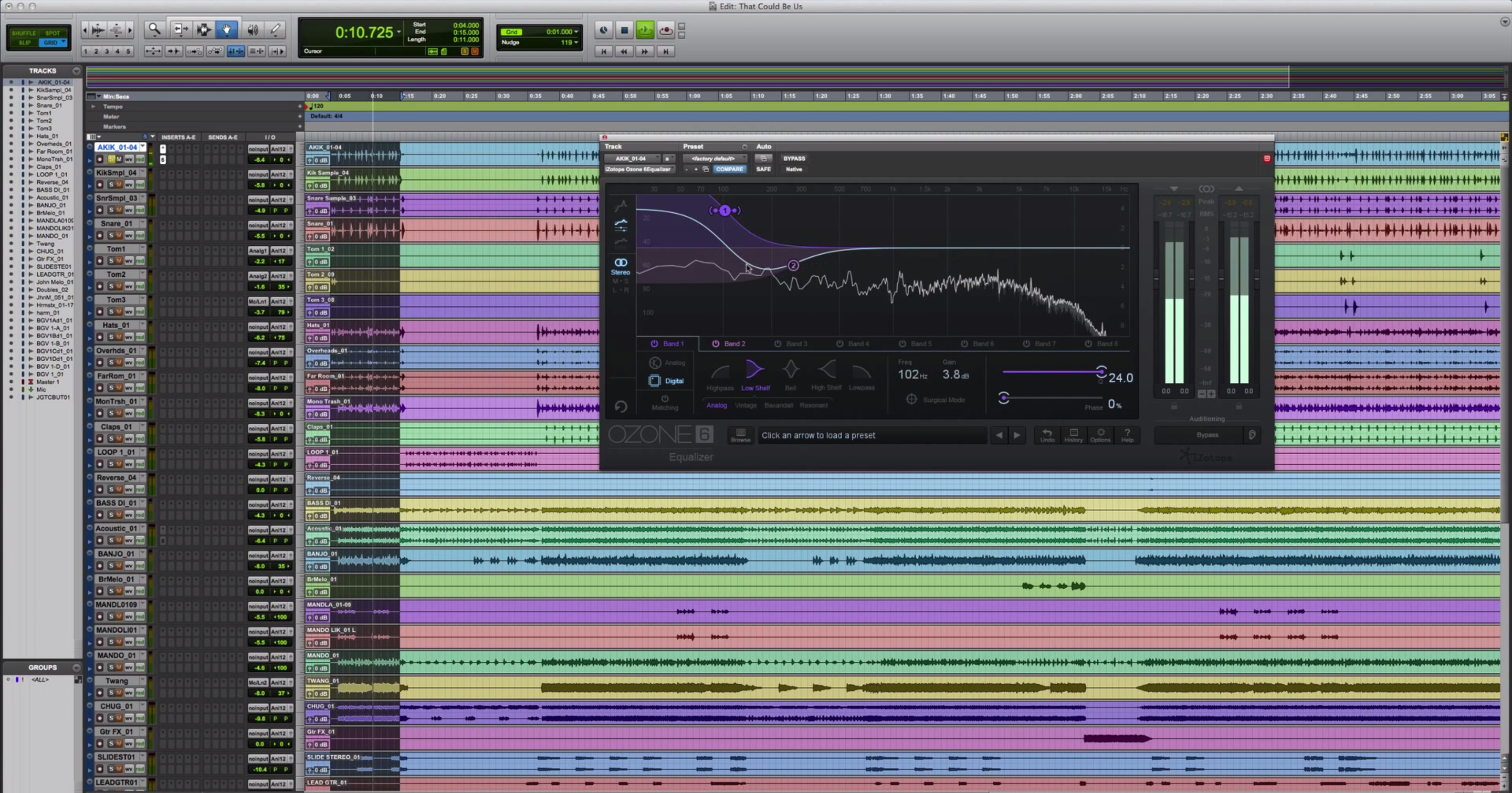Simple vs Complex Plugins
The demonstration I’m going to be showing you here is actually taken from a multi-track session that we’ve worked on over at Mix Practice. So if you want to get your hands on this one and other ones, make sure to check that out.
What I’m going to be doing is a side-by-side, compare and contrast between some of my favorite plugins that I use on almost every session that I work on, with the idea that sometimes, when I’m pulling up a plugin to process a signal, what I’m looking for is a plugin that helps me get simple, easy, fast results.
Other times, I’m looking for a plugin with a bunch of different parameters that I can tweak to dial in the exact perfect tone.
So what I’m going to do is go through several different categories of effects and show you one plugin that helps me get fast results, and other ones that I can use to dial in the sound as much as I want.
So here, let’s start on the mix buss. Here’s a simple example. This is the One Knob Louder plugin from Waves. So on my mix buss, it’s just a matter of turning it on and turning it up, and it’s just going to make things louder. Right? Sounds like this.
[mix, before and after One Knob Louder]
So right? If you’re sitting there in the studio, and you’ve got a client there, and they ask to bring it up to reference level, do some quasi-mastering to it, pull up this plugin and it’ll help you get 90% of the way there.
But it might not be the best limiter to use on the track in the end. Here’s an example of a compressor or a limiter that I like to use. This is the Waves API 2500. It’s on a whole other end of the spectrum. Right?
You’ve got all of these different parameters, like threshold, attack, ratio, and release that you would find on almost every compressor. You’ve got fixed release settings, and you’ve got variable release settings.
On top of that, then you can really dial in the sound by using things like the threshold for the knee, whether you want it hard, medium, or soft. On the detector circuit, you can decide whether you kind of want to beef it up or if you want it to be normal, and then you can do feedback and feedforward kind of compression.
Then if you want, on the stereo version, you can decide if you want it independent — the two left and right channels to be independent from each other, or have some kind of crosstalk with some shaping with it. Right?
If you’re trying to achieve whatever kind of compression sound you want, you’re going to be able to accomplish it by using this plugin.
Let’s go over and look at some other categories of effects. Over here, I’ve got some EQs pulled up. This is one from SofTube. Right? If you’re just starting from the factory default settings when you pull it up.
Let’s use it on this electric guitar and I can show you in just a matter of 10 seconds how I can dial in a sound to kind of take out the harshness on the top end and give it some mid-range clarity, and then beef up the bottom end.
So we’ll put it on this part here.
[guitar, adjusting Pultec]
Just tweaking about three or four different knobs. I can get lots of different sounds.
Then, on the extreme other end of the spectrum, if you’re trying to really tweak things, this is the Waves H-EQ. Tons of different options. So parametric equalizer, where you’ve got control of the gain, control of the Q of these different things, and then also the frequency. Right?
So that’s what you would typically find on an EQ, in addition to those controls. Then you’ve got this dropdown menu if you want to dial in specific models of EQ curves, from the SSL style, to API style, Neve style… Right?
You’ve got these different bands that you can get — you know, get the setting how you’d think you’d like it, and then experiment a little bit. Do you want it to be narrower, wider, this kind of thing, asymmetrical shapes, you name it. If you can think of some kind of EQ curve that you want to dial in, you can accomplish it with this plugin.
Alright, let’s go over here and look at my drum buss.
So in this case, usually, on my drum buss, what I’m looking to try and do is just glue the things — the different tracks together. So I like to use tape saturation for this model tape machines here.
This is a simple easy to use one, and now, it does have a lot of parameters if you want to get into it, but what I like about it is you pull it up, and it sounds awesome right off the bat. So this is the Slate Digital VTM plugin.
So over here on my drums, just turn it on and mess around with the inputs and outputs, and it’s going to sound great.
[drums, adjusting Slate VTM]
Alright, just gives the drums a little bit of life.
Then we’ve got — from Waves — the J37. So this is a plugin where you can set the input/output levels, and then you’ve got a bunch of different options if you want to change the model. Tape speed, formula, wow and flutter, exact amounts of wow and flutter you want, and saturation, bias, right? It’s all here if you want it.
Let’s go over here and look at the vocals. So here, my vocals, I’m going to find a track where I can process it over here. Let’s check out de-essers. Compare two different kinds of de-essers. This is one from Waves. About as simple of a de-esser as there is to use.
It’s already kind of setup right of the bat. It’s all a matter of pulling down the threshold until you find the level where it starts to de-ess things.
[vocals, adjusting de-esser]
Right, five seconds, you’ve got a de-esser. That’s basically doing what you wanted to do.
Then we’ve got the FabFilter Pro-DS with lots of different options. Things to tweak.
Turn this one one, we can set the threshold here, and you can set the range. How much do we want it to turn down?
We can decide in our side-chain filter what frequency range we want to detect. We can audition that, turn it on and off, and we can do split band, which only affects this region, or we can do wide band, which affects the whole frequency region.
Then we can get into side-chain stuff externally. It gives you all of the different kind of options you want.
Now let’s go over and look at harmonic saturators. So here’s the Oxford Inflator. It’s basically a one slider kind of effect. You bring it up, and it’s just supposed to enhance what’s there.
So here’s my piano, let’s listen to that.
[piano]
Right? Just breathes life into it by pulling it up.
Something — a similar kind of plugin that’ll give you the same kinds of results is this Waves Saphira. Cobalt Saphira.
Here though, what you can do is dial in specific amounts of the harmonic saturation that you want with even and odd harmonics. So I can turn the odd and even ones at different levels, right? You can then change the different type here from just a couple of harmonics independently here, or you know, more of them.
So very powerful kinds of things to dial in the exact sound.
Let’s go over here and look at maybe the keyboard part that comes in here. This is where I’m going to be demonstrating delay plugins. H-Delay gets decent results in a couple seconds. Basically, what I’m doing when I bring it in is find the level of the delay I want, amount of feedback, and then the time of it.
I love the fact that it’s already synchronized with the tempo of the song coming in. So let’s tweak this one.
[mix]
Alright, I’ve got the delay sound that I want.
Then, if you want ultimate control, go for this one from FabFilter. Timeless 2. You can get any delay sound you’d ever want to achieve. Right? You’ve got delay time, you’ve got the feedback amount, you’ve got crosstalk amount between two different channels, you can do ping pong delays, you can filter it, multiple filters. You can get in here and modulate stuff. Setup different kinds of modulation. You can get LFOs going, tie these things to different parameters, right?
Those things are all going to just come up with a very creative style delay sound. So definitely one to know about and be able to use there.
Alright, I guess the last one we’ll look at then is some reverb.
So here — most reverbs have several parameters to work with. I like this one from Native Instruments and SofTube — the RC48 — where you really just have to focus on, what are the basic characteristics you want? Length of bass, mid-range, and then what’s the overall size, and those are the main parameters that I’m looking to adjust.
Let’s try it out on some of these vocal parts here.
[vocals]
Alright, that’s about all you need for a basic reverb sound.
Let’s show you another one here. This is the H-Reverb from Waves.
So this one has — you know, a dozen more parameters to adjust. All those things I was working with before, the pre-delay, you’ve got those in here, you can change the amount of the early reflections, and the tail of it, wet/dry, and then you get into kinds of modulations and LFOs and envelopes. You’ve got the EQ built in, you’ve got a separate EQ for the early reflections, right?
You could spend a day just getting the exact kind of reverb sound, plus they have some awesome presets built in for a bunch of different options as your starting point.
So right there you have it, guys. A bunch of different kinds of processors that you can use. I would recommend, as an audio engineer, you should have plugins in your toolkit that help you get fast, simple, decent results. You can pull it up.
Other cases though, you’re going to want to be able to control the overall sound. That’s when you need more parameters to be able to adjust. So it’s good to have both and know when to use them.
So that’s it for today, take care, guys. I’ll catch you next time.






